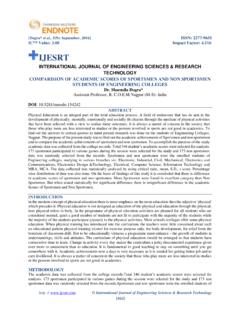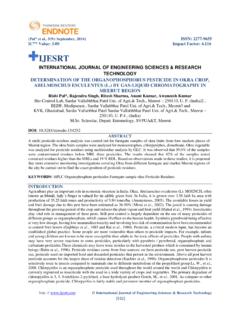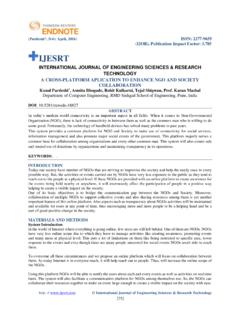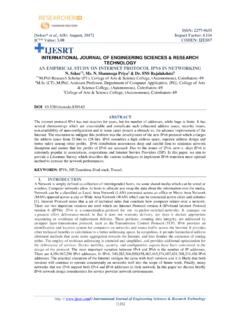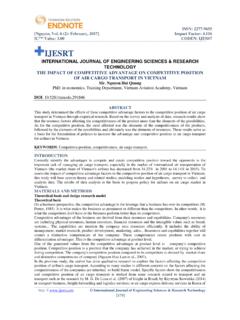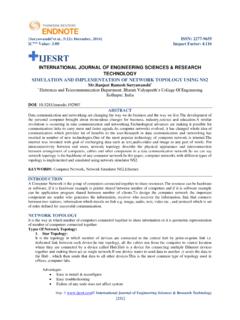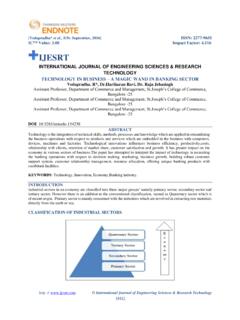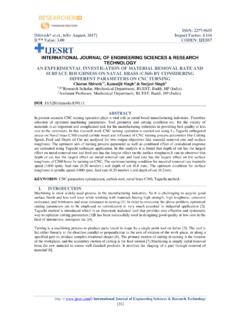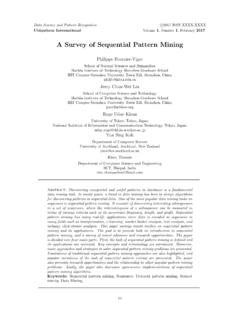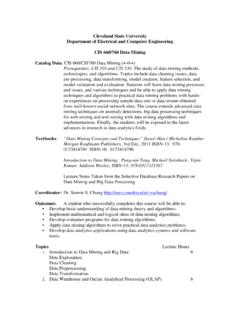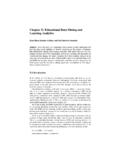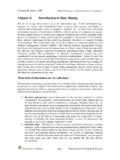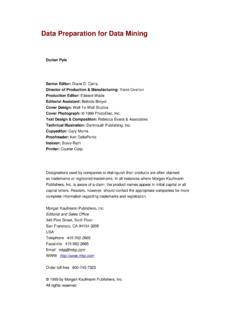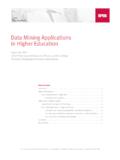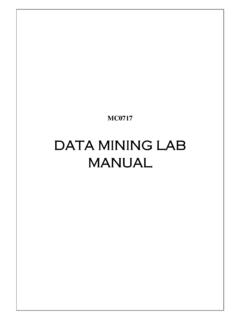Transcription of IJESRT
1 [Sabeena*, 5(4): April, 2016] ISSN: 2277-9655. (I2OR), Publication Impact Factor: IJESRT . INTERNATIONAL JOURNAL OF ENGINEERING SCIENCES & RESEARCH. TECHNOLOGY. FEATURE SELECTION AND CLASSIFICATION TECHNIQUES IN DATA MINING. *, Department of Computer Science, Avinashilingam Institute for Home Science and Higher Education for Women, Coimbatore, India. DOI: ABSTRACT. Data mining is the process of analyzing data from different perspectives and summarizing it into useful information. Feature selection is one of the important techniques in data mining. It is used for selecting the relevant features and removes the redundant features in dataset. Classification is a technique used for discovering classes of unknown data. Classification task leads to reduction of the dimensionality of feature space, feature selection process is used for selecting large set of features.
2 This paper proposed various feature selection methods. KEYWORDS: Data mining, Feature selection, Classification Techniques. INTRODUCTION. Data Mining is the process of extracting large volumes of raw data from hidden knowledge. The health care industry requires the use of data mining techniques as it generates huge and complex volumes of data. The applications of data mining techniques to medical data extract patterns which are useful for diagnosis, prognoses and treatment of diseases. This extraction of patterns allows doctors and hospitals to be more effective and more efficient. The huge volume of data is the barrier in the detection of patterns [1]. Classification task leads to reduction of the dimensionality of feature space, feature selection process is used for selecting large set of features. The term Knowledge Discovery from data (KDD) refers to the automated process of knowledge discovery from databases.
3 The process of KDD is comprised of many steps namely data cleaning, data integration, data selection, data transformation, data mining, pattern evaluation and knowledge representation. Data mining is a step in the whole process of knowledge discovery which can be explained as a process of extracting or mining knowledge from large amounts of data [2]. Data mining is a form of knowledge discovery essential for solving problems in a specific domain. Data mining can also be explained as the non trivial process that automatically collects the useful hidden information from the data and is taken on as forms of rule, concept, pattern and so on [3]. The knowledge excerpted from data mining, allows the user to find interesting patterns and regularities deeply buried in the data to help in the process of decision making.
4 The data mining tasks can be broadly classified in two categories: descriptive and predictive. Descriptive mining tasks defined in the general properties of the data in the database. Predictive mining tasks perform inference on the current data in order to make predictions. According to various goals, the mining task can be mainly classified into four types: class/concept description, association analysis, classification or prediction and clustering analysis [4]. This paper provides a survey of various feature selection techniques and classification techniques used for mining. DATA PREPROCESSING. Data preprocessing is a data mining technique that involves transforming raw data into an understandable manner. Real world data is often incomplete, inconsistent, and/or lacking in certain behaviors or trends, and is likely to contain many errors.
5 Data preprocessing is a proven method of resolving such issues. Data needs to be pre processed before applying data mining techniques which is done using following steps: Data Integration If the data to be mined it derived from different sources data needs to be integrated which involves removing inconsistencies attributes or attribute value names between data sets of different sources. Data Cleaning This step may involve http: // International Journal of Engineering Sciences & Research Technology [160]. [Sabeena*, 5(4): April, 2016] ISSN: 2277-9655. (I2OR), Publication Impact Factor: identifying and correcting errors in the data, filling in missing values, etc. Data Selection In this method where data relevant to the analysis task are retrieved from the database. Data transformation This method involves the data transformed or consolidated into forms appropriate for mining by performing aggregation operations for instance [1].
6 Feature selection The amount of data has been growing rapidly in recent years, and data mining as a computational process involving methods at the intersection of learning algorithms, statistics, and databases, deals with this huge volume of data, processes and analyzes. The purpose of data mining is to find knowledge from datasets, which is expressed in a comprehensible structure. Moreover, in the presence of many irrelevant and redundant features, data mining methods tend to fit to the data which decrease its generalization. Consequently, a common way to overcome this problem is reducing dimensionality by removing irrelevant and redundant features and selecting a subset of useful features from the input feature set [5]. Feature selection is one of the important and frequently used techniques in data preprocessing for data mining.
7 It brings the immediate effects for applications such as speeding up a data mining algorithm and improving mining performance. Feature selection has been applied to many fields such as text categorization, face recognition, cancer classification, and finance and customer relationship management. Feature selection is a process of selecting a subset of features from a larger set of features, which leads to the reduction of the dimensionality of feature space for a successful classification task. In the feature selection technique the data contains many redundant or irrelevant features. Redundant features are those which provide no more information than the currently selected features, and irrelevant features provide no useful information in any context [6]. A feature selection algorithm can be seen as the combination of a search technique for proposing new feature subsets, along with an evaluation measure which scores the different feature subsets.
8 The simplest algorithm is to test each possible subset of features finding the one which minimizes the error rate. This is an exhaustive search of the space, and is computationally intractable for all but the smallest of feature sets. The choice of evaluation metric heavily influences the algorithm, and these evaluation metrics which distinguish between the three main categories of feature selection algorithms: filters, wrapper, embedded and hybrid methods. Feature selection is of detecting the relevant features and discarding the irrelevant features [7]. Feature selection has several advantages. Improving the performance of classification algorithms. Data understanding, gaining knowledge about the process and perhaps helping to visualize it. Data reduction, limiting storage requirements and perhaps helping in reducing costs.
9 Simplicity, possibility of using simpler models and gaining speed. CLASSIFICATION METHODS. Data mining algorithms can be classified into three different learning approaches: supervised, unsupervised, or semi- supervised. In supervised learning, the algorithm works with a set of examples whose labels are known. The labels can be nominal values in the case of the classification task, or numerical values in the case of the regression task. In unsupervised learning, in contrast, the labels in the dataset are unknown, and the algorithm consistently aims at grouping examples according to the similarity of their attribute values, characterizing a clustering task. Finally, semi-supervised learning is usually used when a small subset of labeled is available, together with a large number of unlabeled examples [8]. The classification task can be seen as a supervised technique where each instance belongs to a class, which is indicated by the value of a special goal attribute or simply the class attribute.
10 The goal attribute can take on categorical values, each of them corresponding to a class. Each example consists of two parts, namely a set of predictor attribute values and a goal attribute value. The former are used to predict the value of the latter. The predictor attributes should be relevant for predicting the class of an instance [9]. In the classification task the set of examples being mined is divided into two mutually exclusive and exhaustive sets, called the training set and the test set. The classification process is correspondingly divided into two phases: training, when a classification model is built from the training set, and testing, when the model is evaluated on the http: // International Journal of Engineering Sciences & Research Technology [161]. [Sabeena*, 5(4): April, 2016] ISSN: 2277-9655.
